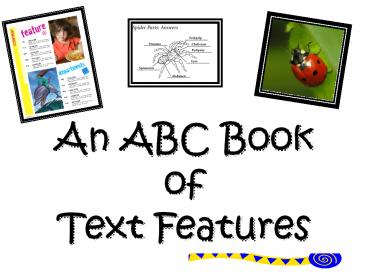An ABC Book of Text Features - PowerPoint PPT Presentation
1 / 27
Title:
An ABC Book of Text Features
Description:
An ABC Book of Text Features A is for Author Notes-A note to readers about making the book. B is for Bold Print-words with thick heavy lines ... – PowerPoint PPT presentation
Number of Views:281
Avg rating:3.0/5.0
Title: An ABC Book of Text Features
1
An ABC Book of Text Features
2
A is for
- Author Notes-A note to readers about making the
book.
3
B is for
- Bold Print-words with thick heavy lines.
-
Brainy Bees Know
Two from Three
4
C is for
- Captions-Information that is near a photograph or
illustration that it tells.
- Honeybees have some
basic numerical abilities, a new study found.
They can - recognize a pattern based only
on the number of elements in it. For example, - if the
bees learn to recognize three blue dots, then
later they can find three
- yellow
stars, three yellow lemons or three purple blobs.
5
D is for
- Diagrams- is a drawing of something to show its
parts. Labels are often added to the diagram.
6
E is for
- Endpages-additional information that supports the
book.
7
F is for
- Fonts-The way the typing looks. You will find
words in bold and color print in books.
8
G is for
- Glossary-A alphabetized list of special words in
a book and their meanings.
9
H is for
- Headings-The title, subtitle, or topic that
stands at the top or beginning, as of a
paragraph, letter, or chapter.
10
I is for
- Index-An alphabetized list of key information
including page numbers. This can be found at the
end of a book.
11
J is for
- Just say it! A pronunciation guide is when the
writer spells out the words phonetically, often
in parentheses. This helps us say the word
correctly. - "The Gila (HE-la) Monster is a kind of lizard."
12
K is for
- Map Key-Helps the reader know how to interpret
information on a map.
13
L is for
- Labels-Helps the reader identify parts of a
diagram.
14
M is for
- Map- Helps the reader understand where things are
in the world.
15
N is for
- Non-Fiction Text Features
- Helps readers better understand what they are
reading about. - Gives us extra information.
- Text features can be found in textbooks, magazine
articles, reports, web pages, and other forms of
non-fiction text.
16
O is for
- ClOse Up- Helps the reader see details in
something small.
17
P is for
- Photographs-Helps the reader better understand a
picture or photograph.
18
Q is for
- Question Format-Questions the author includes in
the text for us to think about.
19
R is for
- Reference pages-Helps the reader understand
information in the book.
20
S is for
- Sidebars-Boxes of information to the side of the
main text/column.
21
T is for
- Table of Contents-Helps the reader identify key
topics in the book in the order they are
presented.
22
U is for
- Underline-Helps the reader understand that a word
or words are important.
23
V is for
- Verso Pages-In page layout, the verso pages are
the even-numbered pages on the left side of a
two-page spread.
24
W is for
- DraWings-Helps the reader understand what
something could have looked liked.
25
X is for
- AppendiX-Additional information located at the
end of a book.
26
Y is for
- CutawaY-Helps the reader understand something by
looking at it from the inside.
27
Z is for
- ItaliciZed Words-Helps the reader understand that
the word italicized is important.































